There’s a lot to love about winter in Scotland – especially if you love the outdoors. The approach of winter just means that you can switch your “toys” (I mean gear) around and get some old friends out of the garage/cupboard. It’s nearly time to dust off the crampons and get the jumpers out so we thought it was time to remind you of the joys of winter.
Who doesn’t love a fresh coating of snow? It makes everything look clean and sparkly. Many of us (not just the kids) see snow and want to rush outside and make footprints. The arrival of snow brings out the inner child in all of us.
You can now legitimately light the fire and enjoy the warmth as well as the aesthetics.
Top tip though: make sure you have lodes your plenty of fuel inside before you begin, because the last thing you want to do is to leave the cosy warmth indoors to head outside for more fuel.
Need I say more – snowball fights are fun with the right kind of snow and can really be multi-generational.

Bring out your creative streak but if you’re going to go large you’ll find it quite a workout. What’s your preference to make his/her features. We’ve had to sacrifice several carrots.
It’s much more mesmerising than watching the rain and far less wet so it can even be enjoyable to watch the snow fall when you’re out in it so long as it’s not a blizzard and you’re not attempting to drive.
Not something everyone will be looking forward to but those who are in root will be looking forward to taking their sharp, pointy toys out of the cupboard and checking them over ready for the forthcoming season.
Why does snow make the landscape so much more attractive? I think it’s because the white of the snow brings out more contrasts and also makes everything look clean and neat. It’s also because the light is magical for taking pictures.
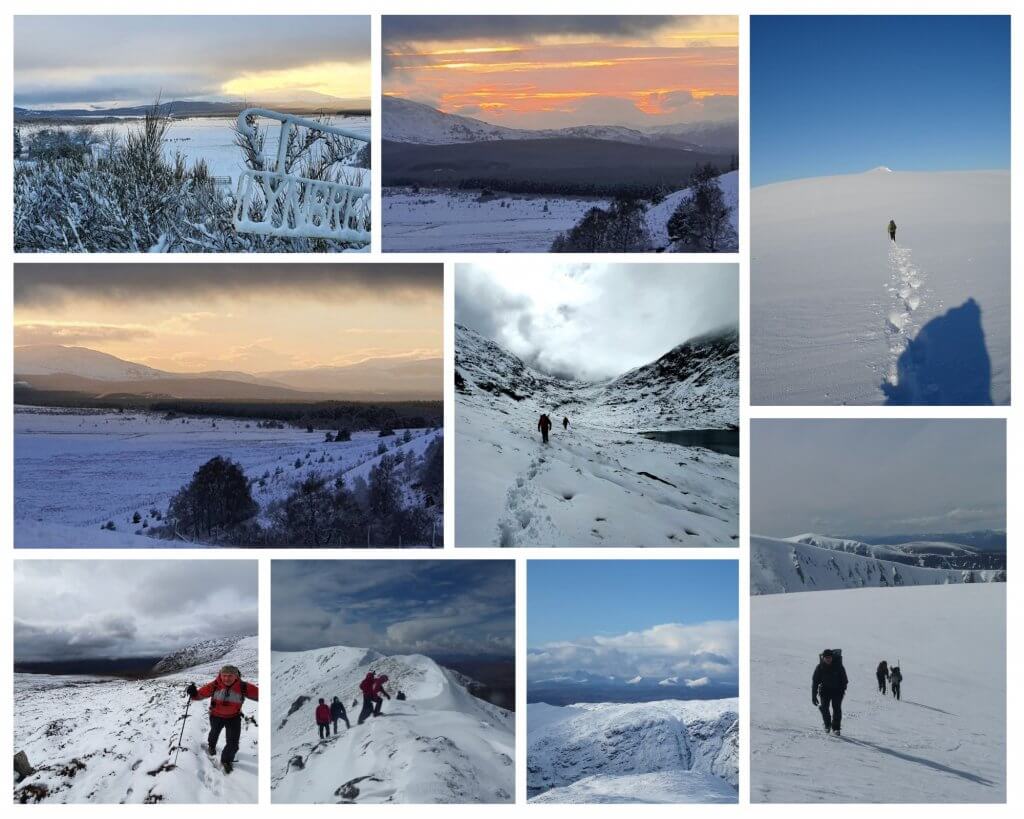
Time to break out all those lovely woolly jumpers.
One of the best things about winter is the lack of bugs, flies and midges.
Frost crystals are quite stunning when you look at them closely.
Look at the image below. Can you believe that all of this is accumulated frost built into the wind from the original structure? This is what the weather station on the top of Cairngorm.
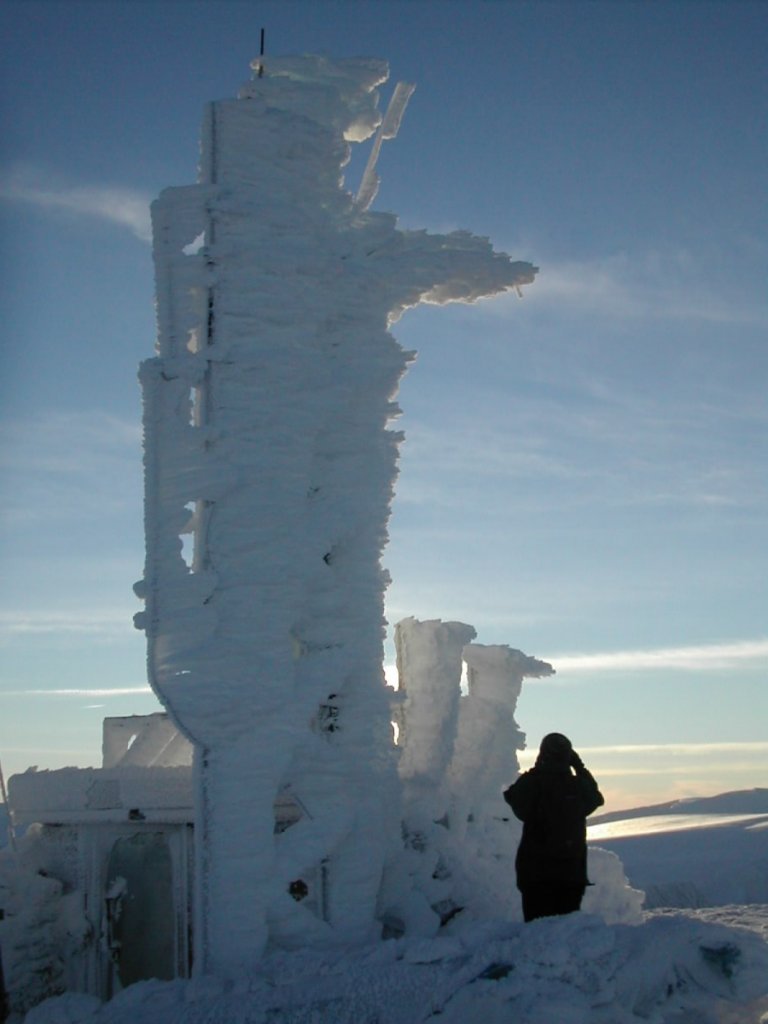
We are so lucky to be living on the edge of ski country. It still surprises us how many people, even those within the UK, who don’t know there is skiing available in Scotland. Yes, we might be suffering from the effects of global warming, but when the weather’s right – a ski day in Scotland is just about paradise.
Ice axe & crampons legitimate adult playing in the snow with sharp, shiny things during winter in Scotland.
When you’re not a kid any more, people tend to frown if you play in the snow. When you’re on a winter skills course, it’s encouraged learn about the snow and ice. You’ll have to slide down a slope with an ice axe, as you’ll need to learn how to stop a sliding fall.
You’ll have to cut holes in the snow, as you’ll need to know how to make emergency shelters – and so much more besides.
Views which stretch for miles are really a thing of winter. The air in summer is warmer and therefore hazier than winter.
Andy has had the privilege of being able to see from Cairngorm to Ben Nevis (55 miles) and has even picked up mountains well to the north all because the cold air is much clearer.
Winter is one of our favourite times of year. We try to keep it to ourselves. It’s not all that hard as so many people seem to be afraid of being cold.
The thing about being out in the winter in Scotland is all it takes is the right level of exercise and the right clothing and you’re sorted.
If you’re worried about it, why not let us be your guides.
Whatever winter sport is your passion, getting the most out of the UK winter season is inevitably about being opportunistic. You need to jump to it when the conditions are right. Getting into the hills requires some degree of planning. You need to learn all the tips you can on about how to forecast snow. When forecasters tend only to predict 3 days in advance, it doesn’t give much time to get organised.
Season passes have been released by Cairngorm Mountain and quite possibly the other ski centres across Scotland. Now’s the time to keep your eye out for the snow predictions.
This changes though when you understand atmospheric thickness and how it relates to the 5 day synoptic weather charts. Have you ever noticed those numbered dashed lines hiding behind the isobars? (see below – on Bracknell charts predicting 36 hrs or more ahead) Well they represent the thickness of the atmosphere and this directly relates to the temperature of the air-mass. Bear with me, here’s the techie bit.
Air pressure at sea level tends to equalise at around 1000mb. The colder the air, the greater the density and hence you need less of it volume wise to create that 1000mb pressure. Therefore the atmosphere is thinner at the poles than it is at the equator. Meteorologists have realised that by measuring the altitude at which the air pressure halves (i.e. is 500mb) they can plot the movement of cold air from the polar regions towards the equator. In the northern hemisphere these thickness lines represent the southern limit of cold air moving down from the north.
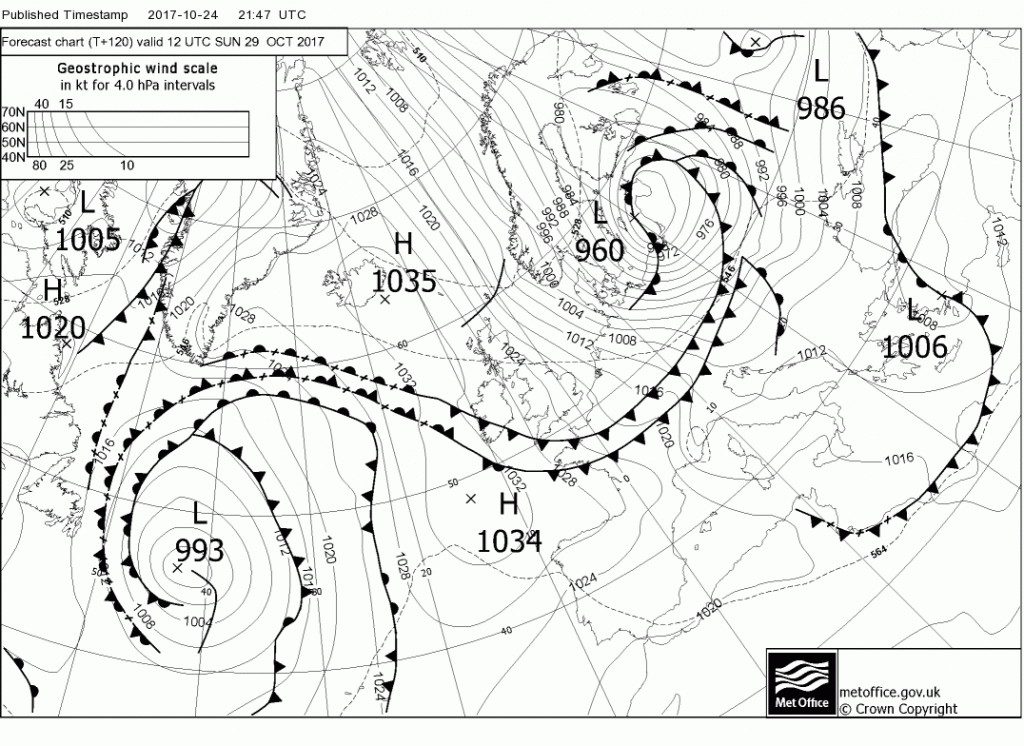
As far as wintry weather in the UK’s mountains is concerned it’s the 528 line (equates to 5280m) you want to watch out for. When it crosses the UK you can expect snow on the hills at least. They are a bit like contour lines. The closer together they are the more the marked the temperature change but if, lets say, the 528 line is 300 miles out to the west over the Atlantic you might be at least be expecting snow on the highest tops in Scotland. If the 510 line approaches the UK wrap up warm, very warm! The charts predicting the arrival of the “Beast from the East” had the whole of the UK enveloped beneath the 510 line!
For those of you who can jump to it and might be in need of accommodation in the Northern Cairngorms area check out Fraoch Lodge.
It’s all in vogue these days. As our normal lives become more and more sedentary, there’s an increasing emphasis on keeping fit. As we get older too, it becomes increasing difficult to maintain our fitness levels. We can’t afford to hibernate over the winter. Instead of heading abroad, we can take on a new experience and continue getting out in the countryside throughout the winter months. If you find the winter weather a challenge or too scary, take a course to give you the confidence to get out walking the hills in winter.
Extra ways of burning calories while walking in winter include:
All of which you can tick when you go hillwalking in winter.
As far as anyone can tell, the “one pound on your feet equals five pounds on your back” notion originated with Sir Edmund Hillary’s successful ascent of Mount Everest in 1953. Since then, numerous studies by academic researchers and even the U.S. Army have concluded one thing on the matter: Weight on the feet is disproportionately more exhausting than weight carried on the torso.* To find out more read the links in our further reading section. Therefore walking in winter boots requires more effort and will burn more calories!
The air in winter is so much more crisp and clear than in the spring/summer months. In spring the large estates who own huge swathes of the Scottish hillside, often start to burn the heather to maintain the grouse moors. Obviously this produces a haze from the smoke which can affect visibility. In the summer the air is generally more hazy due to the humidity which then affects how far you are able to see clearly.
In the middle of winter it is possible to see 100km or more from the high hills. For example, Ben Nevis can clearly be seen from the summit of Cairngorm.
Challenge is the big buzz word these days. Have you run your first marathon? Have you participated in your first triathlon/ironman? Tough Mudder anyone? Compared with challenges like these, winter hill walking is much more accessible and something you could do every day (in season). The biggest challenge for winter hillwalking is building up your stamina when you’re also trying to hold down a full time job. Many of us have deskbound jobs these days and the closer we get to “middle-age” (our 40s and 50s) the more difficult it is to maintain fitness and stamina levels. However, in the course of a week, many people find that their fitness and stamina levels noticeably improve on a guided winter hill walking trip.
On a typical winter walking day out with Andy, the guests record steps in excess of 30,000 per day! You’d be well on your way to your #Walk1000miles at that rate.
Sharing is a major part of walking. People tend to chat as they walk in a group and often end up discussing all manner of topics; setting the world to rights. When you share an interest (i.e. walking) already with the people you’re with, chances are you have topics in common you can discuss without coming to blows. Of course, camaraderie is not something which is confined to winter, but there is something about pitting your skills against the environment which pulls your group together and gives you something to share.
It doesn’t matter what sport you’re enthusiastic about, people love to talk about their gear and share their experiences of using it. When it comes to winter walking, if you’re a novice, you will need to make some investments to upgrade from your summer/autumn walking equipment in order to be safe in the winter hills. If you’re not sure it’s going to be your thing (though if you already enjoy walking, you might get hooked quite easily), you can always hire the technical stuff – winter grade boots, ice axe and crampons, before making the leap yourself into buying the kit.
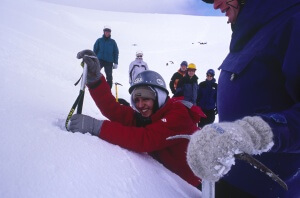
Ice axe arrest on a winter skills course
Sliding around in the snow with a sharp tool – sliding down a hill on your bum – digging in the snow – kicking into ice with crampons – all become legitimate “skills” when you’re on a winter course learning the “personal safety skills” of safe movement on the winter hills.
To go out walking you don’t need to pay for a lift pass for every day you want to go up the hills.
You don’t need to buy the skis and generally you’re further away from the ski lodges, so you don’t have access to the cafes and restaurants, which means you have far fewer opportunities to spend your hard earned pennies.
Gaining new skills and becoming proficient in using them builds confidence not only in the activity you are doing, but also in other areas of your life. It is always a good idea to keep your brain active and to learn new things, particularly if you are also learning new physical skills which will help your body remain fit as well as your brain.
If you’re a novice or if you’re lacking time to gain the skills yourself, remember that winter is harsh environment and not everyone has the experience to head up into the mountains but there are plenty of local, highly-qualified guides who are very happy to take you out.
It’s much more fun to share unusual experiences with your friends. Most people like to see images and videos of adventurous activities, spectacular views, mountains, nature – you can tick all these boxes when you record your experiences out and about in the winter hills, then share then on your favourite social media channel. You’re virtually guaranteed some interaction with your friends/followers.
*A pound on the foot – the science
The Great Outdoor Forum (Stack Exchange) – discussion on the science behind extra weight on your feet.
January 2018 has been a very busy month which Andy is currently rounding off with (another) snowhole trip into the gale-bound Cairngorms with a team from the BBC Travel Show. Nerves were displayed by the newbies presenting the programme. I think they were daunted by the Triathlon enthusiasts who’d been drafted in to help dig.
We welcomed in 2018 in the company of our select winter walkers. The group all brought in the New Year with a great deal of good-humoured and crowded dancing in the street in Grantown on Spey. Dancing was followed by a magnificent firework display. Great fun for everyone which topped off some fabulous snowy walks.
Andy was even able to get out the tentipi and show off it’s capabilities over a cosy whisky in the evening. His market research (which might be skewed by the whisky and warmth inside the tentipi) shows some demand for his pony wilderness glamping proposals.
5 younger enthusiasts joined us on January 1st for the first winter skills and navigation course of 2018. We think the photos tell most of the story. Great fun and quantities of cake kept everyone happy throughout.
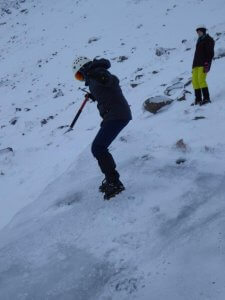
Practising cramponing techniques in the Cairngorms, Scotland. There’s nothing more fun than legitimate play in the snow.
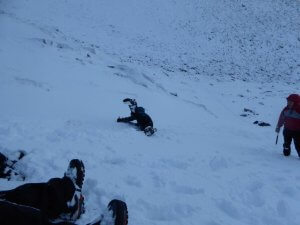
Tumbling down the mountain, alternatively known as ice axe arrest on a 5 day winter skills course with Scot Mountain Holidays
Back for some more trailbreaking through the snow-decked Cairngorms. Our blog advice on how to keep your hands warm and how to keep your phone going in the cold were of great help this week.
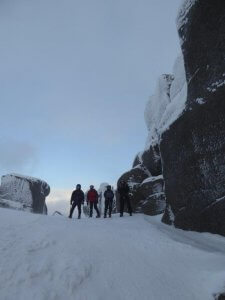
Atop Bynack Mor deep in the heart of the Cairngorms National park. Not everyone goes on to see these magnificent “barns”. Quite a feat of climbing to get to the top, especially after the walk in!
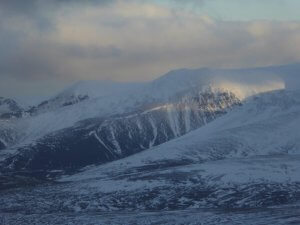
The view you’d be rewarded with for the challenge of pitting yourself against potentially the worst conditions nature can throw at you. When you come out on top, you can feel the adrenaline.
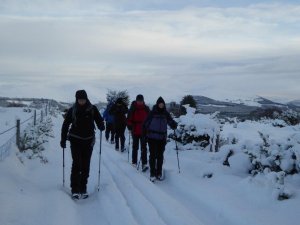
Walking through the snow – January 2018. Winter walking is a completely different experience and a different challenge. If you haven’t tried it, maybe this is your time.
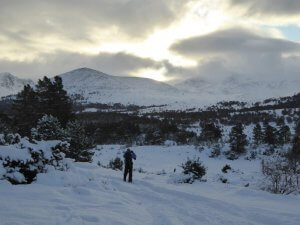
Cairngorms (January 2018) Spectacular views are the reward for challenging yourself to a winter extravaganza.
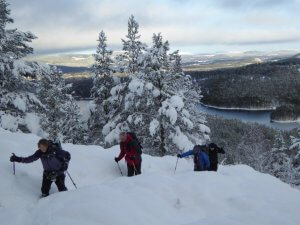
Getting a workout through the snow in the glorious outdoors. Plenty of fresh air and stunning views.
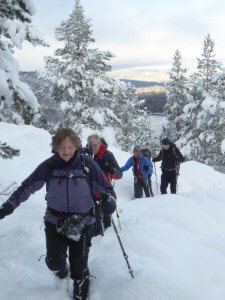
Glorious winter walking on the Classic Winter Cairngorms week with Scot Mountain Holidays this January (2018)
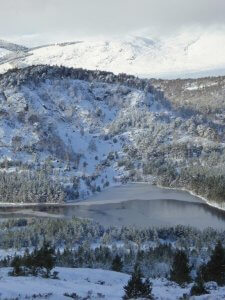
Lucky or what? The views of the Classic Winter Cairngorms week were stunning at times as this shot shows.
Lorna chose to encourage her friends and family to join her on a Snow Hole Expedition with Andy to celebrate her 50th birthday. We felt honoured. Lorna herself must have enjoyed the experience because she’s back right now helping the BBC to dig in tonight. Let’s hope they get to see the blue moon despite the snow showers.
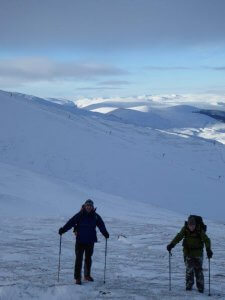
Heading out into the Cairngorms fully prepared for a night out on a Snow Hole Expedition with Andy Bateman
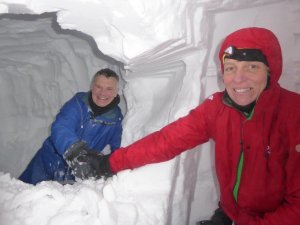
Lorna is enjoying the break through moment. Now they can see that their overnight residence is a real possibility
If you’d like to join us for a winter walking extravaganza or to learn new winter skills, there’s still plenty of time. Winter in the Highlands lasts well into March and sometimes even April.
Plenty of choice of walking holiday or skills course
All content © Copyright Scot Mountain Holidays 2025
Responsive web design by Summit Web Solutions